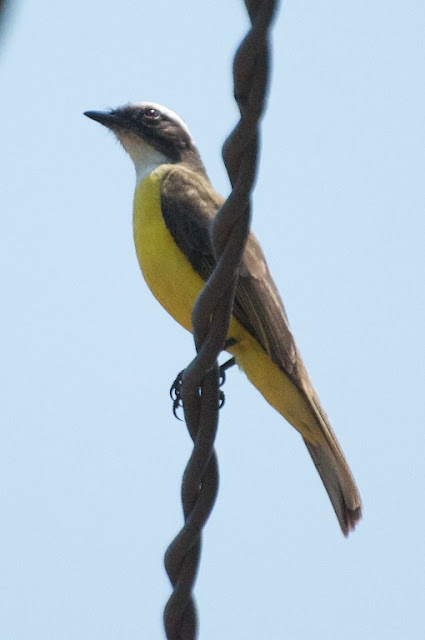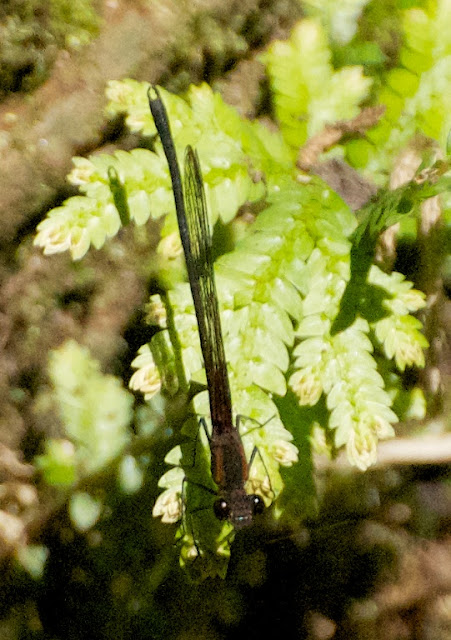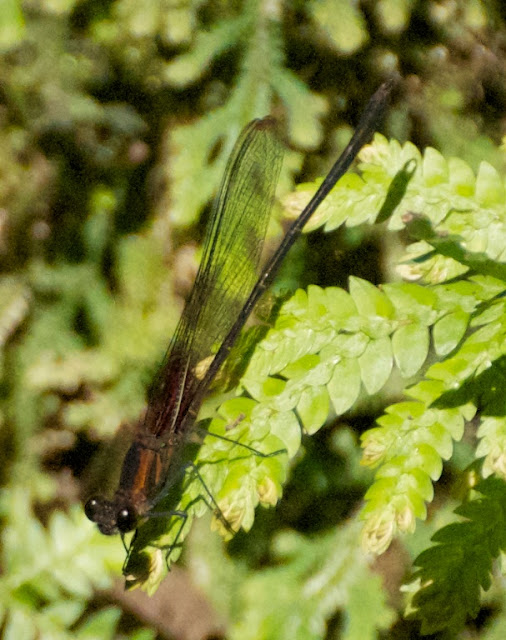Wednesday, March 9, 2016
Mexico: Olmec Country
One of the reasons Eileen and I had to leave Sarawak when we did was that I had to be in Veracruz, Mexico, for the 27th Meeting of the CITES Animals Committee (in late April 2014). That gave us enough time to get back to Canada, catch our breath, scoop up Eileen's son Davin, fly to Florida to check in on my Mom, catch a flight to Mexico City, and change planes for Veracruz.
The flight to the Mexican coast was spectacular, with views of the twin peaks of Popocatapetl and Ixtaccihuatl east of Mexico City...
...and an even closer view of the dome of
The port city of Veracruz has been around for a long time, and has its own points of interest. There was a town here when Cortez arrived in 1519. The structure that Davin is climbing here, the Baluarte de Santiago, dates from 1635; it once formed part of the old city walls.
Nonetheless, I wanted to use what limited opportunities we had, when the meeting wasn't in session, to get out of town. This was not just to see a bit of nature, but to explore some remarkable pre-Columbian history. We managed two excursions with local guides (Eileen and Davin went off on another one day while I was busy at work), one before the meeting and one after. Our first trip, on April 26, 2014, took us inland, towards the old state capital of Xalapa and across the Rio Pescados at the little town of Jalcomulco.
A great deal of the animal life of the American tropics has adapted itself to the presence of bromeliads. This one was serving as a nest base for an Inca Dove (Columbina inca), whose tail you can just see protruding to the right.
I found this female Golden-fronted Woodpecker (Melanerpes aurifrons) exploring the stub of a dead palm. This is a common bird over much of Mexico; it is quite variable, and has sometimes been split into a number of separate species.
The Social Flycatcher (Myiozetetes similis) is one of the most common and ubiquitous birds in tropical America, at least in areas where humans have cleared the forest; you can even find it in cities.
For my Asian friends: this is a tyrant flycatcher (Tyrannidae), no relation to the flycatchers of the Old World. Some ornithologists separate northern birds like this one from the birds in southern Central America and South America, in which case this becomes M. texensis; southern birds would then take the older English name of Vermilion-crowned Flycatcher.
I have often wondered why this highly territorial and aggressive little bird is called "social". The answer was lurking in my library all the time. The following is from The Life of the Flycatcher (1997, p. 138), by the famous and indefatigable chronicler of Costa Rica's birdlife, Alexander F. Skutch: "In southern Tamaulipas, Mexico, George M. Sutton and O.S. Pettingill, Jr. [both of whom, by the way, I knew from ornithological meetings in my student days], watched twelve nests of Vermilion-crowned Flycatchers, each of which was close to the nests of some other species... These discoveries led them to call Myiozetetes similis the Social Flycatcher... They are tolerant of other species but no more social than any of the birds that consort with them".
The most obvious bird in the area, though (and surely the commonest bird around human settlements in Mexico) was the Great-tailed Grackle (Quiscalus mexicanus). These are males (displaying to each other in the upper photograph); like its close relative the Boat-tailed Grackle (Q. major) of the American southeast, the Great-tailed is highly sexually dimorphic. Females are considerably smaller than males, and are brown rather than glossy blue-black.
I only had time to get a quick snap of this Grayish Saltator (Saltator coerulescens). Saltators (the name "saltator" means "jumper") are one of a number of New World songbirds that have been shifted from one family to another in recent years. The dominant oscine, or "true", songbirds in the Americas are members of the so-called "nine-primaried" group. In the Old World they are primarily represented by the buntings (Emberizidae), but in the New they have radiated into a wide variety of forms, and been classified into a number of families (for example, the Icteridae, the family that includes the Great-tailed Grackle). Saltators were long placed in one of these families, the cardinal-Grosbeaks (Cardinalidae), partly on the basis of their heavy, finch-like bills, but molecular evidence has demonstrated that they in fact belong to another, the tanagers (Thraupidae). To make up for this, a number of "tanagers", including all of the birds called "tanager" that breed north of the Mexican border, turn out to be cardinal-grosbeaks. Evolution has an infinite ability to fool us.
The Blue-Gray Tanager (Thraupis episcopus), though, really is a tanager.
Eileen and Davin, meanwhile, had finished their shopping, and we were ready to move on. I had time for a final photo of a Black Vulture (Coragyps atratus) - another abundant and widespread bird.
Our first real destination was a popular waterfall, the Cascada del Texolo, near the old city of Xico (according to Wikipedia, the area has been used as a location for such films as Romancing the Stone and Clear and Present Danger.
Here there are a number of trails into the nearby forest, reached by a bridge over the river gorge. That's Davin in the upper picture.
This, of course, for me, was more like it. I would have preferred to have been there early in the morning, but even at noon there were things to see on our walk.
A concrete-lined impoundment along the trail held numbers of little fish - I can't identify them for certain, but I suspect they may have been one of the platies (Xiphophorus sp) and thus close relatives of some of the most popular inhabitants of tropical freshwater aquaria.
Plants along the forest edge included this one, a member of the Piperaceae or pepper family. It may be one of the enormous genus Piper, with some 2000 species including Piper nigrum, the black pepper of commerce. Plants like this are abundant along trails almost everywhere in tropical America.
I do not know if this hibiscus scrambling down over the lip of the gorge is a native species or a garden escapee.
The forest on the far side of the gorge looked extremely enticing, and I would have loved more time to explore it.
However, I had to make do with what I could find in our limited time along the trail, photographing attractive plants that I could not identify...
...and some, like this epiphytic (tree-growing) bromeliad that I could at least narrow down to family.
At least a few insects were still active in the heat of the day. The Mimic Tigerwing or Heliconoid Ticlear (Melinaea lilis imitata), as its name suggests, is one of a huge complex of orange, black and yellow insects, many of them distasteful or even toxic, that copy each other's appearance to a remarkable degree. They include some 200 butterflies, a few moths and even a damselfly. Many butterflies around the world mimic others, but only in the American tropics do you find so many species, from so many families, that have adopted the same basic pattern.
Admittedly not all of them live in Veracruz, but there are at least ten species there, in eight different genera, that look enough like this one to have given me a great deal of trouble in coming up with an identification (by poring over the photos in Jeffrey Glassberg's A Swift Guide to the Butterflies of Mexico and Central America). Assuming I have got it right, this is one of the clearwings (Ithomiini), so called because many species (not this one, though) have large, scale-free windows in their wings.
I found this Neon Skimmer (Libellula croceipennis) clinging to a vertical stem in a sunny patch at the edge of a forest stream. It is widespread species, ranging from the American southwest southwards into Colombia.
Much harder to spot, as it sat in the shade by a roadside ditch, was this darkly handsome damselfly. It is a rubyspot, a member of a purely American subfamily (Hetaerininae) of the widespread emerald damselflies (Calopterygidae). The name "rubyspot" refers to a reddish patch at the base of the wing. Although rubyspots occur as far north as Ontario, this was my first (and so far only) encounter with one.
Identifying rubyspots is tricky, but I am putting this one down as Hetaerina cruentata, a tropical species that seems to lack a common name, on the grounds that I can just make out (or I think I can) a diagnostic patch of emerald green on the side of its thorax. For a better picture see here.
On our way back to the entrance, I spotted a young Brown Basilisk (Basiliscus vittatus) watching us from behind a rock...
...and a grasshopper, possibly in the genus Abacris, doing the same from a twig.
From the falls we headed into the town of Xico for a brief look at its central square and attractive cathedral...
... and then on to Xalapa for our chief target of the day, its superb Museo de Antropologia. This is a showpiece for the Pre-Colombian cultures that once inhabited this area, including the mysterious Olmecs. The Olmecs flourished here from 2500 to 3000 years ago. They left behind a series of immense, beautifully-carved stone heads (this one is simply known as "Colossal Stone Head No. 1 from San Lorenzo", which gives an idea of how little we know about these things). A tour of the museum is beyond the scope of this blog, but I highly recommend it should you ever visit the area (there are lots of photos on the Museum website).
After our tour of the museum we took a stroll around the nearby park. It was very much a typical urban park, and like many urban parks its most obvious non-human inhabitants appeared to be squirrels.
The squirrels, however, were Mexican Red-bellied Squirrels (Sciurus aureogaster) (or Mexican Gray Squirrels, or just Red-bellied Squirrels), very handsome animals and a "life squirrel" for me. They are found through much of Mexico. Someone introduced them to Elliott Key in Biscayne Bay, Florida, back in 1938. They survived Hurricane Andrew, but an eradication programme was supposed to have exterminated them by 2011.
The amount, placement and intensity of reddish colouration on these squirrels is highly variable - compare this very attractive one to the animal above.
After our visit to Xalapa, with its Olmec heads and colourful squirrels, we headed back to our hotel for a stroll along the oceanfront. Veracruz has had a reputation as a dangerous city (in fact the city police force had to be replaced by navy units to keep things under control), but that didn't seem to bother the locals; as we sat under this rather peculiar statue (I suppose you could call it a mer-shark?) we were passed by a long line of runners, out for, apparently, a charity marathon. They appeared to be having a good time.
Subscribe to:
Post Comments (Atom)


















































No comments:
Post a Comment